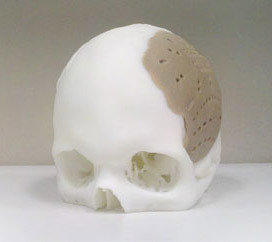Man has 75% of skull replaced with 3-D printed implant
By Salvador Rodriguez
Los Angeles Times
March 8, 2013, 12:35 p.m.

Oxford Performance Materials built a skull implant, like this one, for a U.S. man. The implant was placed surgically this week, replacing 75% of his skull. (Oxford Performance Materials)
_______________
| Some are fascinated with 3-D printing. One man can't get it out of his head.
An unidentified man had 75% of his skull replaced with a 3-D printed implant made by Oxford Performance Materials, a Connecticut company. The surgery this week was the first time a patient received an implant made specifically for him using 3-D printing technology.
The patient, whose name and injury OPM would not disclose, had his head scanned as part of the procedure.
The operation marks a big step in the advancement of 3-D printing technology, the company said. With 3-D printers, users can produce objects with a molding machine based on computer digital models.
The 3-D printing technology is ideal for implants custom-shaped to each patient's anatomy, the company said.
OPM President and Chief Executive Scott Defelice said 3-D printing allows any type of bone to be replaced with an implant. The technology can shorten surgery time, be less risky and cost less, he said.
"We believe our technology is highly disruptive, and it'll widely affect the orthopedic industry," he said.
The type of implant, which is formally known as the OsteoFab Patient Specific Cranial Device, is made out of PEKK, an ultra-high-performance polymer, according to the company's website.
The U.S. Food and Drug Administration approved OPM's technology last month, clearing the way for the surgery.
OPM said it can make an implant within two weeks of getting a patient's scans, and believes that as many as 500 people per month could make use of the implants in the U.S. alone.
latimes.com |




